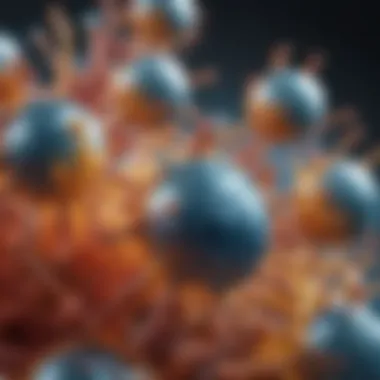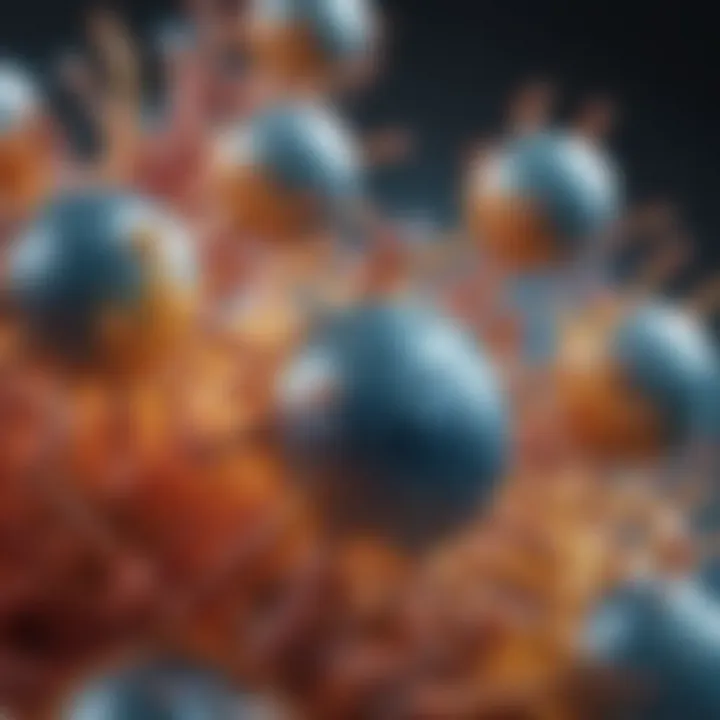Polysulfated Glycosaminoglycan: In-Depth Analysis


Intro
Polysulfated glycosaminoglycans (PSGs) comprise a significant class of biomolecules, recognized for their intricate structures and diverse biological functions. These complex carbohydrates are not just vital for cellular interactions and signaling, but also play pivotal roles in various medical applications. Understanding their structure and function offers insights into their importance in both health and disease. The capacity of PSGs to modulate numerous physiological processes highlights their relevance in therapeutic interventions, making them a subject of ongoing research in biomedical science.
Key Findings
Major Results
The investigation into polysulfated glycosaminoglycans has produced several notable findings that underscore their biological significance:
- Structural Diversity: PSGs exhibit a broad range of structural variants, impacting their biological activity and function.
- Role in Cell Signaling: These molecules participate in key signaling pathways, influencing processes such as gene expression and cell division.
- Therapeutic Potential: PSGs have demonstrated potential in treating various conditions, including osteoarthritis and cardiovascular diseases, through their anti-inflammatory and anticoagulant properties.
Discussion of Findings
Understanding PSGs' structure is essential for grasping their functional roles. Their sulfation pattern, for instance, directly affects their interaction with proteins and other cellular components. This interaction is a significant aspect of their ability to modulate biological responses. Studies confirm that alterations in PSG structure can lead to changes in physiological functions, emphasizing the need for careful exploration of these biomolecules.
Moreover, the therapeutic implications of PSGs are considerable. Research indicates that these compounds can positively influence the healing process and aid in tissue regeneration. Their roles in modulating inflammation and coagulation pathways are particularly relevant for developing new treatment strategies.
Methodology
Research Design
This examination of polysulfated glycosaminoglycans employed a combination of literature reviews and experimental studies. This approach allowed for a comprehensive view of current findings while grounding discussions in empirical evidence.
Data Collection Methods
Data related to PSGs were gathered from various sources:
- Peer-reviewed journals
- Clinical studies and trials
- Meta-analyses
This multi-faceted approach ensures a thorough understanding of the subject while remaining current with the latest research developments.
"The intricate nature of polysulfated glycosaminoglycans reflects their multifaceted roles in biological systems. Understanding these roles can unlock novel therapeutic avenues."
Prelims to Polysulfated Glycosaminoglycans
Polysulfated glycosaminoglycans are pivotal molecules in many biological functions. Their complexity and unique structures make them subjects of considerable interest in biomedical research. This section aims to provide a comprehensive overview of these significant biomolecules, emphasizing their definitions and historical discovery.
Defining Polysulfated Glycosaminoglycans
Polysulfated glycosaminoglycans, often shortened to PSGs, are polysaccharides characterized by their sulfation patterns. These long chains are composed of repeating disaccharide units which generally consist of an amino sugar and a uronic acid. The degree and position of sulfation greatly affect their biological activity, making their study crucial for understanding various physiological and pathological processes.
The structure of PSGs enables their interaction with a range of proteins. This interaction is vital in processes such as cell signaling, inflammation, and tissue repair. Due to the variabilities in sulfation, PSGs can bind selectively to different proteins, influencing various biological outcomes. Their abundance in connective tissues, blood vessels, and even in the extracellular matrix illustrates their significance in maintaining structural integrity and facilitating cellular communication.
Historical Context and Discovery
The historical context of polysulfated glycosaminoglycans reveals a fascinating journey of scientific exploration. The discovery of these complex molecules took place over several decades, starting in the early 20th century. Initial studies focused on the identification of heparin, a form of PSG that exhibited profound effects on blood coagulation.
As researchers delved deeper, they identified other forms of PSGs, such as chondroitin sulfate and dermatan sulfate. These discoveries highlighted the diverse functionalities of PSGs in biological systems. Notably, the sulfation patterns that distinguish one PSG from another were uncovered alongside advancements in analytical techniques, such as chromatography and mass spectrometry. Today, the investigation into polysulfated glycosaminoglycans continues to reveal new insights into their roles in health and disease, establishing their importance in modern biomedical research.
"Polysulfated glycosaminoglycans are central to many biological processes and their unique structures allow for a wide range of interactions with other biomolecules."
In summary, understanding the definition and historical discovery of polysulfated glycosaminoglycans lays a strong foundation for further exploration into their chemical structures, biological functions, and therapeutic applications. This knowledge is crucial for students, researchers, and professionals as they navigate the complexities of biomedical science.
Chemical Structure of PSGs
The chemical structure of polysulfated glycosaminoglycans (PSGs) is integral to understanding their biological roles and potential therapeutic applications. PSGs are composed of repeating disaccharide units, which can be modified through various sulfation patterns. These structural features not only determine their physical properties but also influence their interactions with other biomolecules in the body.
Monomeric Units


Monomeric units are the fundamental building blocks of PSGs, consisting mainly of two sugar molecules: an N-acetylated amino sugar and a uronic acid. These monomers can be diverse, with variations in the amino sugars, which include glucosamine and galactosamine. The specific choice of sugar components affects the overall function and properties of the PSG. Generally, these units are connected by glycosidic bonds, forming long chains that contribute to the complexity and functionality of PSGs. This structure is crucial since it dictates how PSGs interact with various cellular receptors and proteins.
Sulfation Patterns
Sulfation patterns play a significant role in PSG functionality. The location and degree of sulfate groups attached to the sugar units can vary widely. This variation can affect the charge density and, consequently, the binding affinity of PSGs to proteins. High levels of sulfation often enhance the biological activity of these molecules, promoting interactions that are vital for cell signaling and tissue repair. The specific sulfation pattern is a key consideration in therapeutic applications; it can determine how effectively a PSG molecule can modulate biological processes.
Three-Dimensional Configuration
The three-dimensional configuration of PSGs is also crucial to their function. This configuration arises from the unique combination of monomeric units and sulfation patterns. PSGs can adopt a variety of conformations, which can affect their solubility and accessibility to cellular receptors. Understanding these configurations can lead to insights into their biological activity and therapeutic potential. For instance, specific configurations might be more effective at interacting with growth factors or signaling molecules, which is a critical factor in designing drugs that utilize PSGs as therapeutic agents.
"The complexity of PSG structure reflects its multifaceted roles in biology, highlighting the importance of both monomeric composition and sulfation patterns in its function."
In summary, the chemical structure of PSGs, encompassing their monomeric units, sulfation patterns, and three-dimensional configurations, is paramount in elucidating their biological significance. This understanding paves the way for exploring their potential in therapeutic contexts.
Biological Functions of PSGs
Polysulfated glycosaminoglycans (PSGs) have increasingly drawn attention due to their multifaceted biological roles. Their functions underpin a variety of physiological processes, making them essential not just at a cellular level but also in systemic health. Understanding these functions helps clarify their importance in both health and disease.
Role in Cell Signaling
PSGs function as vital mediators in cell signaling pathways. They interact with a range of proteins, including growth factors, cytokines, and receptors. Such interactions can trigger signal transduction processes that influence the behavior of target cells. For instance, PSGs can modulate the activity of fibroblast growth factors (FGFs), which are crucial for cell proliferation and differentiation.
Moreover, the sulfation patterns of PSGs can significantly affect their binding capabilities to these proteins. Different sulfation can lead to distinct biological outcomes. The ability of PSGs to act as both signaling molecules and modulators highlights their functional versatility. Their role in cell signaling is especially relevant in tissues that undergo rapid cell turnover.
Influence on Cell Proliferation
Another significant biological function of PSGs is their influence on cell proliferation. They have been shown to promote the proliferation of various cell types, particularly in connective tissues. Through their interaction with specific cell surface receptors, PSGs can activate pathways that lead to increased cell division.
Research indicates that PSGs facilitate the entry of fibroblasts into the cell cycle, promoting tissue repair and regeneration. This is especially relevant in conditions such as wounds or injuries where increased cell proliferation is necessary for recovery. However, the same proliferative properties can have dual implications. Uncontrolled proliferation can contribute to pathological conditions such as cancer, underscoring the need to investigate PSGs further.
Impact on Tissue Development
The impact of PSGs on tissue development is profound and multifactorial. PSGs contribute to the structure and resilience of the extracellular matrix (ECM), a critical component in supporting cell function and tissue integrity. They enhance the tensile strength and elasticity of connective tissues, playing a role in how tissues respond to mechanical stress.
Additionally, PSGs are important during developmental stages, influencing morphogenesis. They can modulate gene expression linked to tissue differentiation. For instance, during embryonic development, PSGs play a role in guiding cellular interactions that lead to the formation of various tissue types. Their importance in both physiological and pathophysiological contexts makes them a crucial area of study.
The spectrum of biological functions attributed to PSGs indicates their integral role in maintaining homeostasis. Their influence spans from cellular interactions to tissue-level dynamics, affirming their importance in both health and disease.
Understanding these biological functions lays the groundwork for exploring therapeutic applications of PSGs. Their roles in signaling, proliferation, and development can suggest potential pathways for treatment strategies in various diseases.
Synthesis and Catabolism of PSGs
The study of polysulfated glycosaminoglycans (PSGs) inherently includes understanding their synthesis and catabolism. These processes are fundamental, as they dictate the nature, availability, and functionality of PSGs in various biological contexts. By examining these biochemical pathways, one can gain insight into the dynamic nature of PSGs and their critical roles in physiological and pathological states. Understanding the synthesis enables advancements in therapeutic applications, while knowledge of catabolism can uncover how PSGs influence disease progression or resolution.
Biosynthesis Pathways
Biosynthesis of PSGs involves a series of enzymatic reactions that convert simpler precursor molecules into these complex carbohydrates. The fundamental building blocks of PSGs are monosaccharides such as glucuronic acid and N-acetylglucosamine. These sugars undergo various modifications, including sulfation, to create the diverse structures observed in PSGs.
The biosynthetic pathways can be broadly classified into two stages: the synthesis of the core structure and the sulfation process.
- Core Structure Formation: This step involves glycosyltransferases, which are enzymes that facilitate the sequential addition of monosaccharides to form disaccharide units. This portion establishes the backbone of the PSGs.
- Sulfation Process: After the core structure is formed, sulfate groups are added by sulfotransferases. The pattern of sulfation is crucial because it affects the biological activity and interactions with proteins.
These pathways can vary in different tissues or developmental stages, making PSGs versatile molecules in health and disease.
Enzymatic Degradation
The catabolism of PSGs is as intricate as their synthesis. After fulfilling their biological functions, PSGs are subjected to enzymatic degradation, which is crucial for maintaining homeostasis and facilitating turnover in the extracellular matrix.
The degradation of PSGs involves several enzymes, including:


- Hyaluronidases and Sulfate Esterases: These enzymes break down glycosaminoglycans into smaller fragments, allowing for their recycling or removal from the extracellular environment.
- Lyases and Exoglycosidases: These enzymes further degrade the fragments, leading to the release of individual monosaccharides. This process not only recycles the components but also regulates the signaling pathways that are influenced by PSA levels.
Effective catabolism is essential for preventing the accumulation of PSGs in tissues, which can lead to various disorders. The balance between synthesis and degradation is therefore critical for the physiological roles of PSGs, particularly in maintaining the integrity of connective tissues and modulating cellular activities.
The interplay between biosynthesis and catabolism of PSGs determines their biological functions and clinical relevance. Understanding these pathways can inform therapeutic strategies targeting various diseases, including osteoarthritis and cancer.
Polysulfated Glycosaminoglycans in Health and Disease
Polysulfated glycosaminoglycans (PSGs) are not merely structural components in tissues; their involvement in various health conditions is profound and intricate. These biomolecules serve essential roles in facilitating bodily functions and addressing numerous diseases. Understanding their influence on health conditions is critical. It illuminates the pathways through which PSGs can be targeted for therapeutic benefits.
Role in Connective Tissue Disorders
Connective tissue disorders encompass a variety of conditions, including arthritis and lupus. PSGs exhibit a notable protective role in maintaining the integrity of cartilage and other connective tissues. In osteoarthritis, for example, the degradation of cartilage is closely linked to the presence and function of PSGs. They help retain water within cartilage, providing necessary hydration and cushioning. Additionally, the modulation of inflammatory pathways by PSGs can be crucial for preventing joint degeneration.
Research highlights PSGs involvement as natural inhibitors of matrix metalloproteinases, the enzymes responsible for cartilage breakdown. As such, therapies utilizing PSGs or analogs have emerged as potential strategies for managing these disorders, helping to alleviate pain and improve mobility.
Implications in Cardiovascular Diseases
Cardiovascular diseases are a leading cause of morbidity and mortality globally. PSGs contribute significantly to vascular homeostasis. Their ability to bind growth factors and influence signaling pathways is vital for endothelial cell function and vascular integrity. Disruption in PSG function can lead to a cascade of issues, including atherosclerosis, where fatty deposits in arteries are aggravated by inflammatory processes.
Notably, the anticoagulant properties of PSGs like heparin have been pivotal in preventing thrombosis. This unique aspect highlights potential therapeutic applications in cardiovascular therapy. Current studies are also exploring the use of PSGs in preventing restenosis after angioplasty. The ongoing research in this area signifies a promising avenue for enhancing cardiovascular health.
Association with Cancer Progression
The link between PSGs and cancer is complex and multifaceted. PSGs are involved in various stages of tumorigenesis, from initiation to metastasis. They contribute to the modulation of the tumor microenvironment, influencing cellular growth and migration. Certain cancer cells exploit PSG harboring capabilities to promote angiogenesis, the formation of new blood vessels that supply tumors.
In particular, the ability of PSGs to interact with various growth factors implicated in cancer progression is significant. For example, the role of PSG in controlling the availability of angiogenic factors can dictate tumor growth rates. Clinicians are now investigating how manipulating PSGs can possibly hinder cancer progression.
"Polysulfated glycosaminoglycans offer fascinating insights into cell–cell interactions during disease processes."
In summary, the study of polysulfated glycosaminoglycans in health and disease reveals their multifactorial roles. Their impacts stretch across connective tissue disorders, cardiovascular health, and cancer, making them critical areas for ongoing research. Unlocking the potential of PSGs in therapeutic contexts may provide new strategies for treatment and improved patient outcomes.
Therapeutic Applications of PSGs
The exploration of polysulfated glycosaminoglycans (PSGs) in therapeutic contexts reveals significant potential for treating various medical conditions. These biomolecules have garnered attention due to their multifunctional properties, which can enhance treatment efficacy. PSGs can modulate biological processes such as inflammation, tissue repair, and anticoagulation. Their applications span across osteoarthritis treatment, thrombotic diseases, and anti-inflammatory therapies, making them an integral focus of current biomedical research.
Use in Osteoarthritis Treatment
PSGs, particularly substances like glucosamine and chondroitin sulfate, have been examined for their role in osteoarthritis management. Osteoarthritis is a degenerative joint disease characterized by the breakdown of cartilage. PSGs exhibit a chondroprotective effect, helping to maintain cartilage integrity and function. This is crucial because it slows down the progression of the disease, providing patients with symptomatic relief.
Research indicates that PSGs may:
- Enhance joint lubrication by increasing synovial fluid viscosity.
- Inhibit inflammatory mediators such as interleukins and tumor necrosis factor, reducing pain and swelling.
- Stimulate chondrocyte proliferation, which can help repair damaged cartilage.
The incorporation of PSGs in therapeutic protocols presents a minimally invasive approach compared to surgical interventions, often leading to improved quality of life for patients.
Potential in Antithrombotic Therapy
Antithrombotic therapy aims to prevent the formation of blood clots, a critical aspect in managing cardiovascular diseases. PSGs are thought to play a role in this domain by influencing coagulation pathways. They help increase the bioavailability of antithrombotic agents through several mechanisms.
PSGs may:
- Modulate hemostasis, assisting in balancing coagulation and fibrinolysis.
- Enhance the efficacy of drug therapies, such as warfarin or heparin, by providing a synergistic effect.
- Reduce platelet aggregation, thereby lowering the risk of unwanted thrombus formation.
Research into the complex interactions of PSGs within the vascular system proposes their application not only as an adjunct therapy but also as a potentially standalone agent in the management of thrombotic complications.
Exploring Anti-inflammatory Properties
The anti-inflammatory properties of PSGs are another area of interest. Chronic inflammation is at the root of many health issues, ranging from arthritis to cardiovascular diseases. PSGs can mitigate inflammation through various pathways, making them valuable in the development of therapeutic strategies.


Their anti-inflammatory effects include:
- Inhibition of pro-inflammatory cytokines, such as IL-1 and IL-6, which play critical roles in inflammatory responses.
- Promotion of the synthesis of anti-inflammatory mediators, such as transforming growth factor-beta (TGF-β).
- Alteration of immune cell activity, leading to reduced tissue infiltration by inflammatory cells.
The ability of PSGs to modulate these biological processes opens avenues for innovative treatments, prioritizing long-term health benefits without the side effects commonly associated with traditional anti-inflammatory drugs.
"The role of polysulfated glycosaminoglycans in therapy offers a glimpse into the future of personalized medicine, where biomolecules are tailored for specific health needs."
Future Directions in PSG Research
Research on polysulfated glycosaminoglycans (PSGs) continues to evolve at a rapid pace. The future directions of PSG research hold significant promise for both understanding their fundamental roles in biology and expanding their application in clinical settings. As the understanding of these complex molecules deepens, researchers are increasingly focusing on innovative synthesis methods and exploring novel therapeutic uses. This section aims to highlight the critical elements involved in future research of PSGs, emphasizing potential benefits and key considerations.
Advancements in Synthetic Techniques
The synthesis of polysulfated glycosaminoglycans is a challenge due to their complex structures and intricate sulfation patterns. Advancements in synthetic techniques are therefore pivotal for making PSGs more accessible for research and therapeutic use. Recent developments in carbohydrate chemistry, particularly through chemical synthesis and enzymatic synthesis, have shown promising results.
- Chemical Synthesis: This approach has demonstrated the ability to produce synthetic PSGs with defined structures. By using specific reagents and reaction conditions, scientists can control the degree and position of sulfation. This precision allows for the creation of PSG analogs that can be used in functional studies and therapeutic applications.
- Enzymatic Synthesis: Utilizing enzymes to synthesize PSGs offers an alternative that can mimic natural processes. Enzymes can catalyze specific reactions to generate desired polysaccharides, enabling the production of PSGs that closely resemble their natural counterparts. This method presents a more sustainable approach and may reduce the side effects typically associated with synthetic agents.
- Bioengineering Approaches: The integration of bioengineering techniques has introduced novel strategies to modify PSGs using living organisms. This approach can lead to the production of PSGs with unique properties tailored for specific applications.
Advancements in these areas will not only increase the availability of PSGs but also enhance our understanding of their biological roles and clinical relevance.
Investigating Novel Therapeutic Uses
As researchers continue to explore the potential of PSGs, investigating novel therapeutic uses remains a crucial avenue. The versatility of PSGs suggests they could be effective in treating a wide range of medical conditions beyond current applications in osteoarthritis or cardiovascular diseases.
- Regenerative Medicine: PSGs are being studied for their potential in tissue engineering. Their natural presence in the extracellular matrix suggests they can support cell growth and tissue repair, making them valuable in regenerative therapies.
- Neurological Disorders: Emerging research indicates the potential of PSGs in treating neurological conditions. Their ability to modulate cell signaling pathways may offer new strategies for addressing conditions like Alzheimer’s disease and multiple sclerosis.
- Wound Healing: PSGs have shown promise in accelerating wound healing processes. They may enhance angiogenesis and tissue remodeling, which are critical for efficient recovery.
This exploration into novel therapeutic avenues is not only beneficial for expanded medical practices but also encourages the deeper investigation of PSGs in different biological contexts.
"Understanding the complexities of PSGs opens new doors for therapies that could transform patient care across a broad spectrum of diseases."
Challenges in Researching PSGs
Research on polysulfated glycosaminoglycans (PSGs) presents a multitude of challenges that can hinder the progress of scientific understanding and application. These challenges are critical to address, as PSGs have significant implications for health and disease, making their study essential for both basic and applied science fields.
The complexity of the glycosaminoglycan structure is one of the foremost barriers researchers face. PSGs are large, variable molecules with intricate structures that include various monomeric units and sulfation patterns. This structural complexity not only complicates the characterization of these molecules but also makes it difficult to ascertain their precise biological roles and functions. The large size of PSGs further complicates molecular analyses, as various experimental techniques may struggle to provide accurate depictions of their structures.
Complexity of Glycosaminoglycan Structure
Glycosaminoglycans, including PSGs, are composed of disaccharide repeating units. These structures can vary significantly in the arrangement and types of sugars involved, as well as the degree and position of sulfation. Each PSG may exhibit a unique sulfate pattern, thereby influencing its interactions with proteins and other biomolecules. This variability poses a significant obstacle in research, as methods that work well for one PSG type may not be applicable to others. The intricate interplay among different structural components necessitates sophisticated analysis techniques, including high-performance liquid chromatography and mass spectrometry. Many researchers may not have the resources or access to such advanced tools, limiting the scope of their investigations.
Limitations in Current Research Methods
Current methodologies for studying PSGs and their biological functions exhibit several limitations. Traditional techniques may fail to capture the dynamic nature of PSG interactions within biological systems. Many in vitro assays do not adequately mimic physiological conditions, which can result in misleading conclusions about the actual roles of PSGs in vivo. Additionally, the lack of standardized protocols for PSG analysis can lead to inconsistent results across studies. Such variances create challenges in drawing meaningful comparisons and may contribute to gaps in knowledge.
The integration of newer technologies, like CRISPR and advanced imaging techniques, holds promise for overcoming these limitations. However, the adoption of such tools is often slow, primarily due to the need for extensive validation and regulatory approvals. As a result, there remains a reliance on older, less effective methods that can stifle innovation in this research area.
In summary, understanding the challenges in researching PSGs is essential for advancing knowledge in this field. The complexity of their structures and the limitations of current research methods constitute significant barriers. Continuing to explore better methodologies and research designs will be imperative to unlocking the potential of PSGs in both health maintenance and medical treatment.
"Addressing the challenges in PSG research can pave the way for novel therapeutic approaches to treat various diseases."
As research progresses, it will be crucial to build a more comprehensive understanding of how these molecules function across different biological contexts. This endeavor will require collaboration among scientists from various disciplines, creating a multidisciplinary approach that can ultimately enhance the quality and applicability of PSG research.
Closure
Polysulfated glycosaminoglycans (PSGs) are of significant importance in both biological and medical contexts. The understanding of these complex molecules enriches our appreciation of their roles in human health and disease. Studies on PSGs have revealed their essential functions in various physiological processes like cell signaling and tissue development, which underscores their potential therapeutic applications.
Summary of Key Points
In summary, the article has covered the following key points related to polysulfated glycosaminoglycans:
- Chemical Structure: PSGs are complex carbohydrates consisting of disaccharide units that are often sulfated. Their structural variation directly influences their biological function.
- Biological Functions: These molecules participate significantly in cell signaling, proliferation, and various developmental processes, demonstrating their active role in maintaining organ function.
- Health Implications: PSGs are implicated in numerous health conditions, particularly connective tissue disorders and cardiovascular diseases, indicating their relevance in pathophysiology.
- Therapeutic Applications: The exploration of PSGs has led to novel treatments, especially in conditions like osteoarthritis, illustrating their potential effectiveness in clinical settings.
- Future Directions: Upcoming research focuses on enhancing synthetic methods and exploring new therapeutic uses, which may shape the next generation of PSG-related treatments.
Final Thoughts on PSG Significance
The significance of polysulfated glycosaminoglycans cannot be overstated. As we delve deeper into their properties, we uncover not only their vital roles in biological mechanisms but also their potential in therapeutic landscapes. The ongoing research presents exciting prospects, encouraging a shift towards more effective and targeted treatments for a range of diseases.
The evolving understanding of PSGs continues to highlight their multifaceted roles, asserting their position as a cornerstone in both foundational biology and applied medicine.



